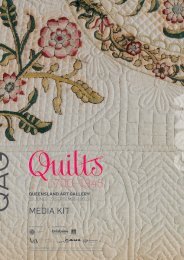1 This PowerPoint slide show is suitable for primary teachers to use ...
1 This PowerPoint slide show is suitable for primary teachers to use ...
1 This PowerPoint slide show is suitable for primary teachers to use ...
Create successful ePaper yourself
Turn your PDF publications into a flip-book with our unique Google optimized e-Paper software.
Robert MacPherson<br />
Robert MacPherson’s Mayfair paintings and installations are based on road signs.<br />
Named after h<strong>is</strong> favourite sandwich bar in Br<strong>is</strong>bane, the works are inspired by the<br />
amateur signage relating <strong>to</strong> food, travel and various <strong>for</strong>ms of community that <strong>is</strong><br />
ubiqui<strong>to</strong>us in the Australian countryside. Mayfair: 18 signs, 18 paintings, "green lizard",<br />
"Double sars" + "Maiden's blush” <strong>for</strong> D.R.M. 1997–2005 has its origins in signs that are<br />
meant <strong>to</strong> be read while moving past in a vehicle. For many travellers, signs evoke a<br />
nostalgia <strong>for</strong> those journeys through rural areas signposted by small handpainted notices<br />
announcing items <strong>for</strong> sale. MacPherson <strong>is</strong> drawn less <strong>to</strong> the exact connotations of words<br />
than <strong>to</strong> the way in which language can conjure images. He util<strong>is</strong>es the slick painted<br />
lettering and erotic wordplay of advert<strong>is</strong>ing sign-writing <strong>to</strong> create a work that <strong>is</strong> humorous,<br />
elegant and provocative. MacPherson highlights the d<strong>is</strong>junction between the ordered<br />
system of language and the world’s chaotic plethora of things that language describes.<br />
(Lynne Seear, ‘Robert MacPherson: Are we there yet?’, in Contemporary Australia:<br />
Optim<strong>is</strong>m [exhibition catalogue], Queensland Art Gallery, Br<strong>is</strong>bane, 2008, pp.138−141.)<br />
Vernon Ah Kee<br />
Vernon Ah Kee takes statements from books, songs, quotes and everyday life and<br />
creates slogans which confront and encourage dialogue about contemporary Aboriginal<br />
experience. In Who let the dogs out 2008 Ah Kee introduces us <strong>to</strong> a character or alterego<br />
that speaks h<strong>is</strong> slogans. ‘Red Hat’ alters, chops up and runs-on words <strong>to</strong> dilute their<br />
negative connotations and <strong>to</strong> change their meaning. Red Hat <strong>is</strong> an anagram of the word<br />
‘hatred’ and Ah Kee bases h<strong>is</strong> character on iconic bushranger Ned Kelly, using a red hat<br />
or helmet, <strong>to</strong> personify the new concept. To Ah Kee, Red Hat has become an Aboriginal<br />
spirit in much the same way. The introduction of th<strong>is</strong> m<strong>is</strong>chievous spirit figure brings a<br />
different reading <strong>to</strong> Ah Kee’s otherw<strong>is</strong>e black-and-white texts. Red Hat also speaks in<br />
Shakespearian verse, reciting lines from h<strong>is</strong> favourite plays and recontextual<strong>is</strong>ing their<br />
ambiguous meanings. Red Hat’s slogans ooze bo<strong>is</strong>terous, boy<strong>is</strong>h appeal.<br />
(Bruce McLean, ‘Vernon Ah Kee: Keeping them in line’, in Contemporary Australia:<br />
Optim<strong>is</strong>m [exhibition catalogue], Queensland Art Gallery, Br<strong>is</strong>bane, 2008, pp.38−41.)<br />
10
















